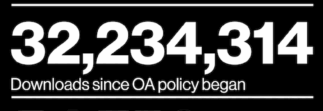In July 2025, the US National Institutes of Health (NIH) announced it will create a policy to limit the amount of NIH funds that grantholders can use towards paying for open access article processing charges. NIH Director Jay Bhattacharya wrote, “I am gravely concerned about the overall financial burden placed on the public—who may fund the original research, then pay again to access the resulting data, publications, or commercial products. In effect, taxpayers may bear multiple costs for innovations their contributions helped enable.”
NIH requested information from the research and scholarly communities to help inform how caps will be implemented. Below is the MIT Libraries’ response to the request.
This post is formatted to be consistent with the NIH’s questions in their submission form. NIH’s questions are in italics.
Proposed policy options
NIH seeks input on the option, or other option not considered in the Request for Information, that best achieves the goal of balancing flexibility in providing research results with maximizing the use of taxpayer funds to support research.
Introduction
NIH’s grant policy on APC costs will have downstream effects on the scholarly communications ecosystem, affecting researchers, research institutions, and publishers. MIT Libraries pay for subscriptions to access scholarly content, and in the last seven years we’ve also increasingly paid for agreements that cover publication costs for MIT researchers, many of whom also receive federal funding. (In 2024, 63% of MIT’s research spending came from federal funders.) We do this by carefully balancing current institutional and researcher needs against a desire for a sustainable publishing ecosystem that prioritizes author rights, access, reuse of scholarship, and transparency.
MIT Libraries’ guiding principles and NIH’s options
MIT Libraries recognizes the dissemination and publication of findings as a defining part of conducting research activities. In 2019, MIT Libraries developed the MIT Framework for Publisher Contracts, which guides decisions around paying for subscriptions and publishing agreements and has been endorsed by dozens of institutions and library consortia. The Framework focuses on ensuring that intellectual control of scholarly content stays with the authors of that content, and it represents a paradigm shift away from paying for access to intellectual property to paying reasonable and clearly defined costs for the value of publishing services. MIT Libraries staff use the Framework to guide negotiations with publishers.
The Framework aligns with the Guidance for Implementing Gold Standard Science, which states that, “agencies shall prioritize transparency in scientific research to ensure accountability and public trust.” It also aligns with the NIH goal to maximize the value of research grants: One of the Framework’s core principles is that we should pay a fair and sustainable price to publishers. And it reflects a shared interest in preserving prior licenses to scholarly content. Like the Government Use License relied on by NIH, MIT authors rely on the MIT Open Access (OA) license to share their work, and one principle of the Framework is that “[n]o author will be required to waive any institutional or funder open access policy to publish in any of the publisher’s journals.”
Responsible stewardship of federal spending on research and publishing should focus on:
1) Fairly compensating all contributors in the value chain, which in turn requires transparency in compensation models. (See MIT Framework, “Institutions will pay a fair and sustainable price to publishers for value-added services, based on transparent and cost-based pricing models”; see also Plan S, “[OA fees] must be commensurate with the publication services delivered and the structure of such fees must be transparent to inform the market and facilitate the potential standardisation and capping of payments of fees.”; see also Open Science Monitoring Principles.)
2) Providing public resources for the sustainability of the scholarly communication ecosystem — e.g., if not through journals, then available to repositories and preprint services — which is a public good essential for societal advancement. (In addition to the MIT Framework principle quoted above, see A Grand Challenges-Based Research Agenda for Scholarly Communication and Information Science; Information wants someone else to pay for it: Laws of information economics and scholarly publishing; Interventions in scholarly communication: Design lessons from public health.)
3) Building in mechanisms for evaluation, learning, and adjustment of a funding policy based on its direct effectiveness and its alignment with the core goals of fair compensation, sustainability, and aligning incentives. (See Interventions in Scholarly Communication, above; see also Evaluating Peer Review at NIH.)
4) Helping to realign researcher incentives away from publishing in “prestige” journals and towards a more open, transparent, fair system in which scientific outputs are promptly available to the public. (See Grand Challenges, above; Assessment reform and publishing reform need to go hand in hand; Saying ‘No’ to Rankings and Metrics; Assessing scientists for hiring, promotion, and tenure.)
NIH Option 1: Disallow all publication costs.
Option 1 expresses skepticism about pay-to-publish open access (OA) models. While skepticism in this financial model is reasonable (see, e.g., Open for Business), it remains true that editing, administering peer review, and distributing scholarly content does cost money, and a blanket prohibition on publication costs may be too blunt an instrument. Moreover, prohibiting article processing charges (APCs) without supporting alternative publication modes fails as a policy to establish the incentives and resources necessary for sustainable public access. Allowing for reasonable compensation for expenses is a necessary part of the scholarly publishing ecosystem, and publication-side costs, if managed sustainably and with fair, transparent pricing, are not inherently wasteful. NIH should focus on ensuring that publication-related costs are reasonable and transparent, for example, through our suggested option described below.
NIH Option 2, 4, and 5: Set a limit on allowable costs per publication, on the total amount of an award that can be spent on publication costs, or a combination of both.
If NIH is going to contribute to publication costs, a cap is a reasonable option, but perhaps should not be the only consideration. A cap based on the expected cost of publishing the article, backed up with transparent accountability for those costs, could be a measure used (see, e.g., Counting the Cost: A Report on APC-Supported Open Access Publishing in a Research Library for an example of calculating cost-based pricing).
As a general rule, however, caps that are not accompanied by transparency requirements risk increasing the overall costs as publishers assume the availability of those funds. A cap that is not contingent on some criteria that incentivizes keeping costs reasonable is therefore unlikely to succeed at the stated goal to “maximize the value of each research grant.”
While we believe that an approach based on the percentage of the award allows change over time more flexibly, there remains the same problem that the grant funds are not necessarily tied directly to publishing models that are sustainable and transparent. An amount up to a cap or a percentage that does not meaningfully add value towards the publication is still a waste of public funds. A better approach, as described below, would be to condition contribution to publication costs on publishing in a venue that meets criteria aligned with NIH’s goals.
NIH Option 3: Set a limit on allowable costs per publication and allow a higher amount to be paid when peer reviewers are compensated.
Option three identifies an interesting criterion that could be used to assess whether publication costs will be covered. The uncompensated labor of peer reviewers is an important topic, and could be a criterion that NIH uses to determine whether publishing costs are being put towards a sustainable and fair publishing ecosystem. As proposed, this option would, however, require a substantial increase in the transparency of publication and peer review processes, and oversight into accurate use of this criterion has the potential to be administratively burdensome. If that administrative burden could be overcome, then this criterion could be adopted, possibly alongside others, as a contingency affecting the amount of covered publication costs.
MIT Libraries recommendations: no hybrid payments and green OA enforcement
As NIH Director Jay Bhattacharya wrote in July: “I am gravely concerned about the overall financial burden placed on the public—who may fund the original research, then pay again to access the resulting data, publications, or commercial products. In effect, taxpayers may bear multiple costs for innovations their contributions helped enable.”
If NIH seeks to move the OA publishing market towards reasonable cost-based compensation without excessive payments by the public or double dipping by publishers, we think publication costs should only be covered when payment furthers transparent and sustainable publishing. This also leads to lower costs overall, by tying compensation to production costs.
Specifically, NIH should encourage a dual route to public access policy compliance: If an article will be published in a subscription or “hybrid” journal, public access should be accomplished via use of the Government Use License to deposit the author’s accepted manuscript into PubMed Central. If an article will be published in a fully-OA journal, publication costs are permitted.
Public access policy compliance via “green” OA (through deposit of the author’s accepted manuscript in an open repository such as PubMed Central) is well established, and many publishers have permitted it for years, both in response to funder policies and institutional OA policies such as MIT’s. The vast majority of publishers do not require authors to waive institutional OA policies, demonstrating the viability of this route.
Grant funds should be used only for publication costs in fully OA journals, i.e., journals that do not also charge subscription fees. Administratively, compliance with this criterion is easy to determine via indexing in the Directory of Open Access Journals (DOAJ), which only indexes fully OA journals. Covered costs in such journals could also be capped at a reasonable rate based on estimated reasonable publishing costs and a set amount of overhead. Additional criteria could also be added to ensure funds are used toward a sustainable publishing ecosystem, such as allowing costs (or, allowing uncapped costs) only when a journal meets specified transparency standards, which could be developed specifically for this purpose, or could adopt an existing framework (see, e.g., the Fair Open Access Breakdown of Publication Services and Fees). Such criteria could potentially include provisions for peer review compensation, as discussed above in relation to option 3.
We also strongly recommend that NIH disallow covering costs when publishers prohibit the use of prior licenses (such as the Government Use License or institutional OA policies) in their author contracts. This would remove the incentive to publishers to use the NIH Public Access Policy as a strong-arm tactic for requiring payments from authors instead of allowing green OA compliance.
This option would not affect where authors could publish. Authors who choose to publish in hybrid journals would still be welcome to do so and could use the green OA route for public access policy compliance, but they would not be permitted to use taxpayer money to pay additional costs. This is similar to the criteria used by many academic institutions, including MIT Libraries, in deciding when to cover publication charges. MIT Libraries (until affected by recent budget cuts) administered an OA fund for MIT authors using the criteria of indexing in DOAJ and a fixed cap of $1000 per article.
Conclusion
NIH policy around coverage of publication costs should reflect the ultimate goals of a financially sustainable publishing ecosystem and public access to publicly funded research. As such, NIH should adopt clear criteria that support those goals. We recommend that NIH support two routes to Public Access Policy compliance: 1) For papers published in subscription-only or hybrid journals, require compliance only through the Government Use Policy and do not cover additional publication fees; 2) for papers published in fully-OA journals, cover publication fees to an amount reasonably and transparently related to a sustainable cost of publication.
Available evidence related to publication costs and proposed options
NIH seeks any evidence (either from your own work or other publicly available sources) that can be publicly shared that addresses the considerations of one or more of the options.
Recommended data sources:
Stefanie Haustein, NIH explores capping APCs: Let’s look at the evidence, ScholCommLab (Sept. 3, 2025),
Haustein, S., Schares, E., Alperin, J.P., Camargo, F., Matthias, L., Céspedes, L., Poitras, C., & Strecker, D. (2025). APCs of 2,228 journals where NIH-funded authors published in 2025 (Version v1) [dataset]. Harvard Dataverse.
Steinhart, G., & Skinner, K. (2024). The Cost and Price of Public Access to Research Data: A Synthesis. Zenodo.
Peer review compensation
NIH is interested in hearing ideas about factors related to paying for peer review. Specifically, NIH invites input on factors that NIH should consider in determining whether peer reviewers are appropriately compensated.
As discussed further in our answer to question 1, we recommend that, if peer reviewer compensation is considered, it should be considered alongside other criteria that support sustainable and transparent public access to research.
Publishing best practices
In addition to compensating peer reviewers, other kinds of publishing best practices, such as use of automated fraud detection capabilities, may contribute to higher publishing costs. NIH is seeking further input on additional factors that it should consider in determining the allowability of a higher per publication cost.
As described further in the response to question 1, NIH should consider whether NIH funds are supporting a sustainable publishing business model when contributing to publishing costs. The NIH should not provide publishing costs for publications that seek to thwart public access by prohibiting authors from using the Government Use License. NIH should also not provide publishing costs for “hybrid” journals; publishing costs for such journals are already covered by subscription payments, and the Government Use License should be used to provide public access.
Other comments
NIH welcomes input on any aspect of the RFI.
Underlying issue: Incentives
A zero-embargo mandate can place authors in tension between funder and publisher: The Government Use License solves one problem by giving NIH the right to make the articles available; however, some publishers create another by requiring authors to represent and warrant in their author contract that no such prior license applies to the article. Some publishers are being very clear that they will consider reliance on the Government Use License breach of contract. See, e.g., SpringerNature federal agency compliance FAQ: “Because authors warrant under our subscription licensing terms that they haven’t committed to licensing any version of their article under a licence inconsistent with the terms of our agreement – including the applicable embargo period – publication under the subscription model isn’t suitable for authors whose funders require no embargo” (emphasis omitted).
Authors are often strongly incentivized to publish in venues that create this problem. In order to get jobs or promotions, they need to publish in “prestigious,” high-impact journals, no matter the publisher policies or costs. These journals, from publishers like Elsevier, SpringerNature, and the American Chemical Society, often have the tightest control over author rights and/or the most expensive APCs.
APC caps or green OA mandates cannot by themselves change how authors define and measure merit and success. This is a much larger project, requiring action from researchers, institutions, librarians, publishers, and funders. If federal agencies like NIH want a scholarly publishing system that is truly open and serves all researchers and the public, they must play a role in realigning incentives.
We implore the NIH to use its financial power to help motivate a shift in researcher incentives toward community-controlled publishing models such as diamond open access, in which neither authors nor readers are responsible for payment and open infrastructure. When evaluating researchers’ publication track records in grant applications, for example, NIH should focus less on the “prestige” or impact factor of the journals in which they publish and more on their open science practices.


